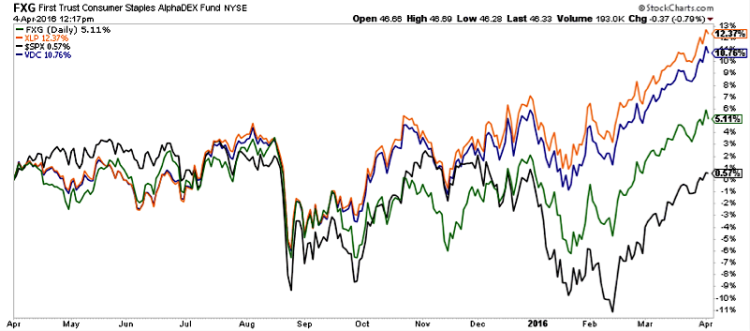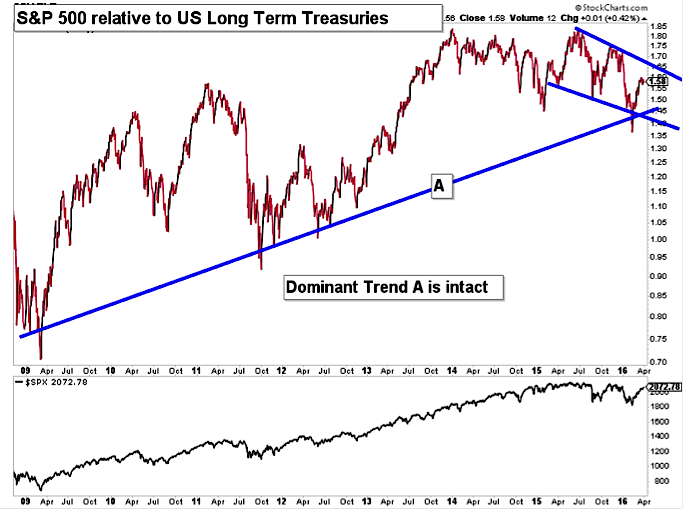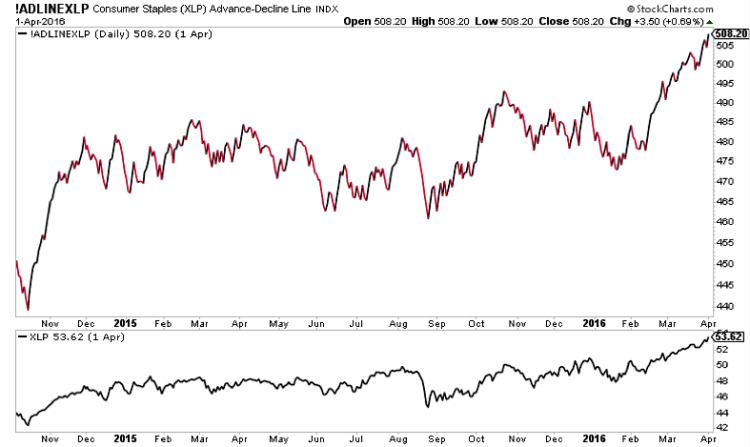Consumer staples stocks aren’t considered the sexiest sector in the market. Companies that make diapers or sell food just aren’t as exciting as cutting-edge cyber security firms or social media rock stars. Nevertheless, the non-cyclical business models of these businesses make for a formidable investment theme with consistent revenue and proven track records.
For those very reasons, consumer staples stocks are considered a defensive area of the market and are often bought up during periods of excess volatility. The first quarter of 2016 certainly proved a fruitful environment for this sector and closer examination will prove why this segment has been to be so reliable this year.
KOW WHAT YOU OWN: CONSUMER STAPLES ETFs
Reviewing The Playing Field – David Fabian
The Consumer Staple Select Sector SPDR (XLP) is the most well-known benchmark in this group. XLP is home to 39 large-cap food, beverage, household products, and tobacco stocks. This ETF boasts a market cap weighted distribution allocated to $10.3 billion in assets and charges an expense ratio of 0.14%.
XLP holds a relatively small group of companies, but its returns have only been eclipsed by utility stocks in the S&P 500 Index so far this year. This ETF has gained nearly 7% in 2016 and just recently hit new all-time highs. Clearly investors are banking on the stability of low volatility stocks in this uncertain environment.
Another slightly broader index is the Vanguard Consumer Staples ETF (VDC), which owns 100 large and mid-cap consumer staples stocks. VDC is similarly market cap weighted and has $2.8 billion in assets. This ETF also charges an ultra-low expense ratio of just 0.10%.
It’s worth noting that both of these consumer staples ETFS (XLP and VDC) share many of the same top holdings such as Proctor & Gamble (PG) and Coca-Cola Co (KO). As a result, these two ETFs offer very similar price patterns and return characteristics. Ultimately, it may come down to a preference for the fund company rather than any meaningful characteristic that separate these investment vehicles.
If you want to find a truly unique offering, the First Trust Consumer Staples AlphaDEX Fund (FXG) is worth a look. This ETF takes a smart beta approach by constructing its portfolio based on fundamental factors such as recent price appreciation, sales growth, cash flow, and return on assets.
The end result is a very different makeup than its more traditional peers. FXG contains 40 consumer staples stocks with a significant emphasis on food products businesses. It also charges a noticeably higher expense ratio of 0.62% due to its variant index methodology.
Technical Action – Aaron Jackson
Let’s compare these consumer staples ETFs with the S&P 500.
Notice the passively managed funds are significantly outperforming smart beta fund FXG.
Also, note that all three are drastically outperforming the S&P 500. This tends to happen when the market is in a defensive posture.
How do we know when the market is in a defensive posture? One way is to look at the stock to long term treasury ratio.
Over the last nine months, this ratio has trended lower suggesting an interest in securities with yield.
Finally, let’s look at breadth of the group. The XLP advance-decline line is trading at new highs, just like the fund. This suggests healthy demand for stocks in the group moving forward.
Conclusions
- The market’s defensive posture lends itself to an environment where Consumer Staples ETFs lead the market.
- Many ETFs are constructed with similar offerings. At the end of the day, the biggest differentiators are expense ratios and liquidity.
- Smart Beta ETFs once again prove to be over-managed and lead to lower returns than passively managed counterparts. What exactly are you getting for your increased management fee?
- While the market’s recent rally has been very impressive, defensive, consumer staples stocks are still leading.
Thanks for reading!
This article is part of a series co-authored by David Fabian (fmdcapital.com) and Aaron Jackson (northstarta.com). Each week we will be unlocking the secrets to some of the most talked-about exchange-traded funds in the market. The goal is to better understand what you own or elevate new ideas to the forefront of your watch list.
Twitter: @fabiancapital @ATMCharts
Any opinions expressed herein are solely those of the authors, and do not in any way represent the views or opinions of each other or any other person or entity.











